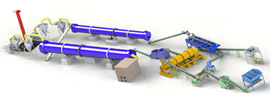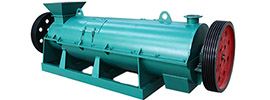Polyurethane-coated urea is a slow-release fertilizer that utilizes polyurethane membrane technology to control nutrient diffusion, extending the fertilizer's effectiveness period (typically 3–6 months). The core principle involves leveraging the hydrophobic and semi-permeable properties of polyurethane films to regulate urea molecule release. Below is a detailed breakdown of its production workflow and key technical considerations:
I. Raw Material Preparation
1. Primary Components
- Urea Granules:
- Particle size: 2–4 mm or 4–6 mm (uniformity required).
- Quality standards: Purity ≥98%, moisture content ≤0.5%.
- Polyurethane Prepolymer:
- Synthesized from isocyanates (e.g., MDI, TDI) and polyols (e.g., polyester/polyether polyols).
- Control isocyanate group (-NCO) content at 10–20%.
- Chain Extenders:
- Examples: 1,4-butanediol (BDO), ethylenediamine (EDA), used to adjust polyurethane crosslinking density.
- Catalysts:
- Organotin (e.g., dibutyltin dilaurate) or amine-based catalysts to accelerate curing.
2. Auxiliary Materials
- Solvents:
- Ethyl acetate or acetone (some processes adopt solvent-free systems).
- Anti-caking Agents:
- Talc or diatomaceous earth to prevent particle aggregation.
- Colorants:
- Iron oxide red for product identification.
3. Pre-treatment
- Urea Screening:
- Remove dust and broken granules via vibrating screens to ensure size consistency.
- Prepolymer Storage:
- Store under dry nitrogen protection to prevent moisture-induced reactions.
II. Coating Process: Fluidized Bed Coating (Industry Standard)
This method suspends urea granules using airflow, enabling uniform polyurethane spraying and curing. Key steps include:
1. Fluidized Bed Preheating
- Load urea into a fluidized bed reactor and heat to 50–60°C using hot air (60–80°C).
- Purpose: Eliminate surface moisture to enhance polyurethane adhesion.
2. Polyurethane Solution Spraying
- Solution Preparation:
- Mix prepolymer, chain extender, and catalyst (e.g., 9:1 ratio of prepolymer to extender).
- Dilute with solvent (if needed) to achieve viscosity of 500–2000 mPa·s.
- Alternative: Dual-component spraying (A: prepolymer; B: extender + catalyst) for on-site mixing.
- Spray Parameters:
- Nozzle pressure: 0.2–0.5 MPa for fine atomization.
- Spray rate: 10–50 kg/h (adjusted to prevent clumping).
- Coating thickness: 50–200 μm (thicker layers slow release further).
3. Curing Reaction
- Conditions:
- Thermal curing: 80–120°C for 5–30 minutes.
- Moisture curing: Room temperature with catalysts (for solvent-free systems).
- Critical Controls:
- Avoid temperatures >130°C (risk of urea decomposition).
- Ensure complete extender reaction to prevent residual -NCO groups (which may harm roots).
4. Multi-layer Coating (Optional)
For extended release:
- Base Layer: Polyurethane (50–100 μm).
- Middle Layer: Wax or silicone oil for enhanced hydrophobicity.
- Top Layer: Inhibitor-containing coating (e.g., nitrification inhibitors) to regulate nitrogen transformation.
III. Post-treatment Processes
1. Cooling
- Cool granules to <40°C via fluidized bed cooling or conveyor systems to prevent caking.
2. Screening
- Use vibrating screens to classify particles by size (target: 2.0–4.75 mm, ≥90% compliance).
3. Anti-caking Treatment
- Apply 0.1–0.5% anti-caking agent via rotary drum mixers for uniform coverage.
4. Quality Inspection
- Nutrient Content: Nitrogen ≥42% (GB/T 2440-2017 standard).
- Controlled-Release Performance:
- Water dissolution test: Measure nitrogen release at 24h, 7d, and 28d (e.g., ≤15% at 24h; ≥80% at 28d).
- Soil incubation test: Simulate field conditions to assess release curves.
- Physical Properties: Particle size distribution, crush strength (≥10 N/particle), moisture (≤1%).
IV. Key Process Parameter Controls
- Polyurethane Membrane Properties
- Crosslinking density: Adjusted via extender dosage (higher density = slower release).
- Porosity: Maintained at 5–15% to balance controlled release and initial nutrient availability.
- Coating Uniformity
- Optimize fluidized bed airflow (0.3–0.8 m/s) to avoid dead zones.
- Position nozzles to cover the entire reactor cross-section.
- Environmental Controls
- Maintain workshop humidity ≤60% to prevent polyurethane moisture absorption.
- Use negative-pressure solvent recovery systems to minimize emissions.
V. Typical Production Equipment
- Fluidized Bed Reactor
- Type: Horizontal multi-chamber or circulating fluidized bed.
- Material: Stainless steel (304/316L) for corrosion resistance.
- Spray System
- Nozzles: Two-fluid (air + solution) for optimal atomization.
- Pumps: Gear or diaphragm pumps for stable flow.
- Curing Equipment
- Hot air ovens or infrared heaters for rapid temperature control.
- Screening & Packaging
- Vibrating screens (linear or circular) and automatic bagging machines (25/50 kg/bag).
VI. Environmental & Safety Measures
- Waste Gas Treatment
- Solvent recovery: Condensation + activated carbon adsorption (recovery rate ≥90%).
- Tail gas purification: RTO (regenerative thermal oxidizer) or catalytic combustion for VOC removal.
- Wastewater Management
- Treat equipment cleaning water via sedimentation/filtration for reuse.
- Safety Protocols
- Personal protective equipment (respirators, gloves) for handling isocyanates/solvents.
- Emergency showers/eyewash stations and fire extinguishers (CO₂/dry powder) on-site.
VII. Process Optimization Trends
- Solvent-Free Coating
- Use reactive polyurethane prepolymers for direct spraying and curing, eliminating solvent pollution.
- Smart Release Membranes
- Develop temperature- or pH-responsive polyurethanes to synchronize nutrient release with crop demand.
- Low-Cost Raw Material Substitution
- Replace petroleum-based polyols with bio-based alternatives (e.g., castor oil, rapeseed oil) to reduce costs.
VIII. Applications
Polyurethane-coated urea is suitable for:
- High-value crops: Vegetables, fruits, and flowers requiring precise nutrient control.
- Field crops: Corn and wheat to minimize labor via reduced top-dressing.
- Landscaping: Lawns and ornamental plants to prevent nutrient runoff.
By enabling on-demand nutrient release, this technology improves fertilizer utilization efficiency (40–60% higher than conventional urea) while reducing ammonia volatilization and nitrate leaching, aligning with sustainable agricultural practices.
This translation maintains technical precision while ensuring clarity for an English-speaking audience in the fertilizer industry. Let me know if you need further refinements!
 Send us a Email
Send us a Email Wulong Industrial Cluster
Wulong Industrial Cluster Have any question?
Have any question?



















